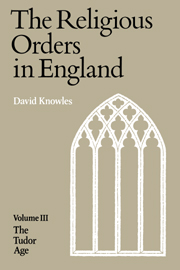Book contents
- Frontmatter
- Contents
- Preface
- List of Abbreviations
- Part One The Tudor Scene
- Chap. I The reign of Henry VII
- Chap. II Some monastic activities
- Chap. III The Cistercians
- Chap. IV The Premonstratensians
- Chap. V The friars in the early sixteenth century
- Chap. VI Sixteenth-century visitations
- Chap. VII Monastic personalities
- Chap. VIII Humanism at Evesham
- Chap. IX William More, prior of Worcester, 1518–36
- Chap. X Butley and Durham
- Part Two The Gathering Storm
- Part Three Suppression and Dissolution
- Part Four Reaction and Survival
- Appendix I Sir Thomas More's letter ‘to a monk’
- Appendix II Religious houses suppressed by Cardinal Wolsey
- Appendix III The witness of the Carthusians
- Appendix IV Houses with incomes exceeding £1000 in the Valor Ecclesiasticus
- Appendix V The sacrist of Beauvale
- Appendix VI Itinerary of the visitors, 1535–6
- Appendix VII The commissioners for the survey of the Lesser Houses in 1536
- Appendix VIII The conflict of evidence on the monasteries
- Appendix IX The last abbots of Colchester, Reading and Glastonbury
- Appendix X Regulars as bishops
- Bibliography
- Index
Chap. X - Butley and Durham
Published online by Cambridge University Press: 08 January 2010
- Frontmatter
- Contents
- Preface
- List of Abbreviations
- Part One The Tudor Scene
- Chap. I The reign of Henry VII
- Chap. II Some monastic activities
- Chap. III The Cistercians
- Chap. IV The Premonstratensians
- Chap. V The friars in the early sixteenth century
- Chap. VI Sixteenth-century visitations
- Chap. VII Monastic personalities
- Chap. VIII Humanism at Evesham
- Chap. IX William More, prior of Worcester, 1518–36
- Chap. X Butley and Durham
- Part Two The Gathering Storm
- Part Three Suppression and Dissolution
- Part Four Reaction and Survival
- Appendix I Sir Thomas More's letter ‘to a monk’
- Appendix II Religious houses suppressed by Cardinal Wolsey
- Appendix III The witness of the Carthusians
- Appendix IV Houses with incomes exceeding £1000 in the Valor Ecclesiasticus
- Appendix V The sacrist of Beauvale
- Appendix VI Itinerary of the visitors, 1535–6
- Appendix VII The commissioners for the survey of the Lesser Houses in 1536
- Appendix VIII The conflict of evidence on the monasteries
- Appendix IX The last abbots of Colchester, Reading and Glastonbury
- Appendix X Regulars as bishops
- Bibliography
- Index
Summary
THE BUTLEY CHRONICLE
A monastic chronicle of the decades immediately preceding the Dissolution is so rare as to be almost unique; the register of Butley Priory, therefore, though in itself jejune, and rendered still more so by curtailment in transmission, deserves for this reason alone a brief mention.
Butley, a house of Austin canons founded in 1171 by Ranulf Glanvil, had enjoyed throughout its history an uneventful and tolerably prosperous existence. It lay at the head of a creek in East Suffolk between Aldeburgh and Felixstowe, where the salt marshes gave way to heath and rough pasture, and these in turn to the great oaks and solitary rides of Staverton forest. The tidal waters in the medieval centuries washed the timbers of a wharf within little more than a hundred yards of the monastery, and stone for the fabric of the church had been floated thither from the valley of the Yonne in France. The fabric was large, and the endowment substantial from both manors and churches in the neighbourhood. The armorial frieze of the gatehouse, one of the most remarkable works of its kind to survive, is an impressive instance both of the ability of a remote house to commission craftsmen of the first rank and of the ramifications of its patronage among the regional nobility and gentry. Appropriately enough, the relations of the house with these people is one of the chief interests of the chronicle.
The short register or chronicle, in form a mixture of both types of book, runs from 1510 to 1535 and was probably the work of the subprior, William Woodbridge.
- Type
- Chapter
- Information
- The Religious Orders in England , pp. 127 - 138Publisher: Cambridge University PressPrint publication year: 1979



